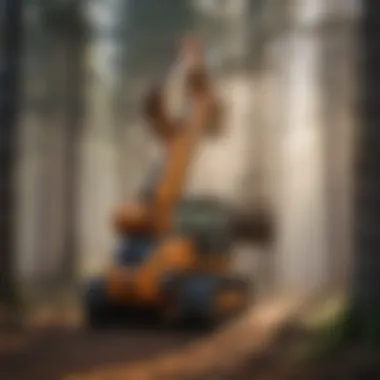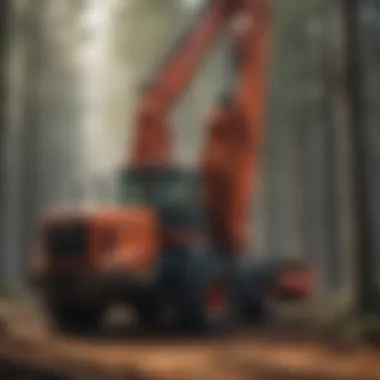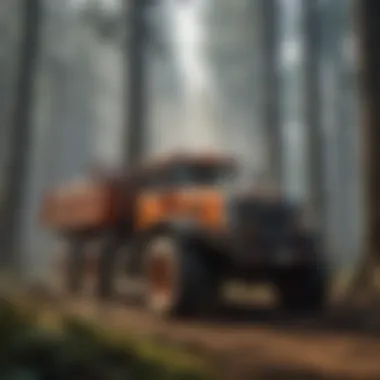Understanding Tree Harvester Pricing: Key Insights


Intro
Understanding tree harvester pricing begins with recognizing the complex interplay of factors at work in the forestry sector. As technological advancements reshape the equipment landscape, it becomes crucial for stakeholders to comprehend not just the prices of tree harvesters but also the elements impacting these costs. This article aims to provide a thorough overview, examining everything from operational considerations to market trends.
Understanding Forestry Practices
Forestry practices evolve based on ecological, economic, and social dimensions. These definitions and strategies guide the management of forest resources. Each aspect plays a significant role in determining the pricing of tree harvesters.
Types of Forestry Practices
- Sustainable Forestry: This approach emphasizes maintaining forest health while extracting resources responsibly. It focuses on minimizing environmental impact and maximizing longevity of forest ecosystems.
- Commercial Forestry: Prioritizing profit, this practice involves intensive harvesting methods aimed at maximizing output. It often requires advanced technology, thus influencing the cost of tree harvesters.
- Community Forestry: Involvement of local communities in resource management. Its inclusive nature can drive demand for affordable harvesting equipment.
Historical Context
The forestry sector has undergone significant transformations in pricing over decades. Early practices relied heavily on manual labor, resulting in lower equipment costs but higher operational times. As awareness surrounding sustainability grew, so did the need for more advanced machinery. This historical perspective allows one to understand the current market dynamics and pricing structures in place.
Principles of Woodland Stewardship
Woodland stewardship encompasses the responsible management of forest resources, balancing economic benefits with ecological health. It is essential to consider this when examining harvester pricing.
Conservation Techniques
Employing conservation techniques ensures that harvesting practices do not compromise forest integrity. This includes:
- Selective Logging: Extracting only certain trees while preserving the overall forest structure.
- Reduced Impact Logging: Limiting damage to surrounding trees and soil during harvesting, which requires specialized equipment.
Managing Forest Resources
Effective management involves several strategies that impact tree harvester costs:
- Monitoring Forest Health: Regular assessments can lead to more informed decisions regarding harvesting, maintaining equipment, and ultimately costs.
- Technological Integration: Using modern technology can increase efficiency, but also increase initial investment costs of machines.
Sustainable Forest Management
Sustainable forest management seeks to meet the needs of the present without compromising future generations. Understanding its core elements further clarifies tree harvester pricing.
Certification Standards
Certification programs such as the Forest Stewardship Council and the Sustainable Forestry Initiative validate responsible forestry practices. Compliance often requires adopting specific harvesting techniques and equipment, influencing prices.
Economic Benefits of Sustainability
Investing in sustainable practices can yield long-term economic benefits:
- Market Demand: Consumers increasingly prefer products from sustainably managed forests, potentially increasing market value for certified forestry products.
- Cost Savings: Efficient use and maintenance of harvesting equipment can lead to long-term savings despite higher initial costs.
"Sustainable practices not only enhance forest health but can also lead to improved economic outcomes for forestry professionals."
In summary, understanding the intricacies of tree harvester pricing involves more than just surface-level examination. It requires delving into the myriad factors that affect costs from technological investments to operational practices and certification standards.
Prelims to Tree Harvesting Equipment
Tree harvesting equipment forms a critical component in the forestry industry. Understanding this equipment is essential for making informed decisions in the purchasing process. This section aims to outline how tree harvesters operate, their significance in forestry, and the overall impact on forest management.
One key element of tree harvesting equipment is the tree harvester itself. These machines can efficiently and effectively cut, process, and load trees. They range in size and sophistication, designed to suit various needs in the forest. Understanding the different models helps buyers determine which equipment is best for their operations.
The primary benefits of using advanced tree harvester machinery include increased productivity, safety, and reduced operational costs. With the right equipment, forest operators can complete tasks faster and with greater precision. Moreover, these machines often come with features that reduce environmental impact, which is becoming increasingly relevant in today’s market.
In this overview, we will explore the anatomy of tree harvesters and the technology that powers them. We will delve into both the practical and financial aspects necessary for understanding tree harvesting equipment. Thus, it's important for stakeholders to grasp how these machines work and their related costs, to optimize their forestry operations.


Overview of Tree Harvesters
Tree harvesters are specialized machines designed for logging and processing trees. They can handle various functions, including felling trees, delimbing, and bucking them into logs. This multifunctionality is crucial for efficiency. Most modern tree harvesters operate with advanced hydraulic systems that enable them to perform these tasks with precision and speed.
Typically, a tree harvester consists of a tractor base equipped with a harvesting head. The harvesting head is the part that performs most of the cutting and processing. For example, models from companies like John Deere and Komatsu are well-known for their robust and efficient designs. Understanding how the equipment is designed and its capabilities helps buyers make informed choices.
Beyond that, it's vital to consider the ergonomic aspects of these machines. Comfort and ease of use can lead to better operator efficiency and less fatigue. Other features, such as visibility and controls, play significant roles in operational effectiveness.
Importance in Forestry Operations
Tree harvesters are not just tools; they play a fundamental role in the sustainability and efficiency of forestry operations. Their integration into forest management practices leads to a more controlled and scientific approach to logging.
- Increased Efficiency: Tree harvesters significantly reduce the time and labor needed for logging operations. Traditional methods can take longer and require more workforce.
- Improved Safety: Modern tree harvesters are equipped with safety features that minimize the risks associated with logging. For instance, enclosed cabs protect operators from falling debris and adverse weather conditions.
- Sustainable Practices: With attention to sustainability, tree harvesters can help reduce damage to surrounding trees and ecosystems. Precision in cutting allows better planning, which is critical for long-term forest health.
In summary, the importance of tree harvester equipment cannot be overstated. They are not merely machines; they are integral to the current and future practices in forestry, shaping how timber resources are managed responsibly.
"Understanding tree harvesting equipment is not just beneficial; it is vital for sustainable forestry practices."
As we proceed through this article, further sections will delve into the various factors that influence tree harvester pricing and how they affect the overall financial implications for forestry operators.
Factors Influencing Tree Harvester Price
Understanding the factors that influence tree harvester pricing is critical in making informed purchasing decisions. Several elements play a role in determining the cost of these complex machines. From the model and specifications to brand reputation and technology integration, each factor carries weight in the final price tag. An analysis of these aspects can empower forestry professionals and businesses to choose equipment that not only fits their budget but also meets their operational requirements. Here, we delve into the four primary considerations affecting tree harvester prices.
Model and Specifications
When evaluating tree harvester prices, the model and specifications stand out as primary determinants. Different models cater to varying operational needs. For instance, a specialized harvester designed for selective logging often costs more than a general-purpose model. Specifications, such as engine size, cutting head type, and tracked or wheeled configuration, also come into play. Higher specifications typically mean increased efficiency and productivity, which can justify a larger initial investment. Thus, assessing the specific needs of your operation is essential.
Brand Reputation
Brand reputation significantly affects pricing in the tree harvesting equipment market. Established brands like John Deere and Caterpillar often command higher prices due to their history of reliability and performance. These companies invest in research and development, leading to superior technology and durability in their machines. A reputable brand may offer better resale value as well, making it a wise long-term investment. In contrast, unknown or lesser-known brands might sell at a lower initial cost but could pose risks in terms of performance and maintenance support.
Technology Integration
In today’s market, technology plays an essential role in determining tree harvester pricing. Features such as automation, GPS, and advanced data analytics enhance efficiency and precision in operations. For example, harversters with integrated telematics allow operators to monitor machine performance in real-time, leading to better maintenance schedules and improved productivity. However, these cutting-edge technologies typically come with higher price points. Businesses must weigh the costs against expected benefits carefully, especially if they aim for long-term gains in operational efficiency.
Condition: New vs. Used
The condition of the tree harvester can dramatically influence its price. New machines often come with a premium, justified by factory warranties and the latest technology. However, the used market can provide more budget-friendly options, albeit with different considerations. Used equipment may have hidden wear and tear that could lead to costly repairs. Comprehensive inspection and evaluation are necessary to ensure that a used harvester will serve its purpose effectively. Ultimately, the choice between new and used must factor in both upfront costs and long-term maintenance expenses.
Market Trends Affecting Pricing
Market trends play a critical role in determining the pricing structure of tree harvesters. Understanding these trends allows buyers to make informed decisions and helps manufacturers to adjust their strategies accordingly. Fluctuations in pricing can be attributed to several interconnected factors, which influence not only equipment costs but also operational efficiency in forestry practices.
Supply Chain Dynamics
The supply chain for tree harvesters is complex and influenced by numerous factors. Any disruption in the supply chain can lead to significant price changes for tree harvesters. Manufacturing delays, shortages of parts, and transportation issues can all affect availability and, consequently, pricing. Moreover, global events such as natural disasters or pandemics can cause upheavals. When demand surges but supply tightens, prices often increase.
- Key factors in supply chain dynamics include:
- Material costs: Fluctuations in the cost of raw materials, such as steel, can impact production costs.
- Manufacturing capacity: Limitations on production capabilities can lead to scarcity in the market.
- Logistical costs: Rising transportation expenses often correlate with higher end-user prices.
Understanding these dynamics assists buyers in forecasting potential future expenses. Knowledge of current supply issues allows for proactive buying choices before inevitable increases occur.
Global Economic Factors
Global economic conditions are pivotal in influencing tree harvester pricing. The state of the economy affects everything from investment in infrastructure to timber prices. For instance, economic growth generally leads to increased construction activity, which heightens demand for timber, driving up prices for tree harvesters as more equipment is needed for tree removal and processing.
- Economic indicators to monitor include:
- Gross Domestic Product (GDP): Higher GDP can indicate a robust economy, leading to increased spending on forestry equipment.
- Interest rates: Fluctuating rates can affect financing options for buyers.
- Global trade policies: Tariffs and trade agreements can influence the cost of imported machinery and parts.


By tracking these indicators, stakeholders can gain insights into when to make purchases, ensuring they do not overpay in a booming market.
Demand for Sustainable Practices
In recent years, there has been a growing trend towards sustainability in forestry practices. The demand for sustainable tree harvesting methods not only impacts operational practices but also influences pricing. Equipment that is marketed as environmentally friendly or capable of efficient timber management may command higher prices due to their advanced technology and features.
- Considerations in this demand include:
- Consumer preferences: Increasingly, consumers are favoring products that are produced sustainably.
- Regulatory pressures: Governments may implement regulations that require more sustainable operations, which affects equipment specifications.
- Market differentiation: Companies that emphasize sustainability can leverage this for competitive pricing strategies.
Understanding this trend allows buyers to align themselves with sustainable practices, thus, potentially offsetting costs through efficiency gains and attracting customers who value eco-friendly operations.
Cost Considerations Beyond Purchase Price
When evaluating the total cost of ownership for tree harvesters, one must consider factors beyond the initial purchase price. Understanding these additional costs can make a significant difference in the long-term financial viability of any investment in forestry equipment. This section explores important aspects such as maintenance, operational expenses, and financing options. Addressing these considerations ensures that forestry professionals can make more informed decisions regarding their equipment purchases.
Maintenance and Repairs
Maintenance and repair costs are critical elements that often get overlooked when calculating the total cost of tree harvesters. Regular servicing is essential to ensure that equipment runs efficiently and minimizes downtime. Failure to adhere to a proper maintenance schedule can lead to increased wear and tear, resulting in higher repair costs.
Factors influencing these costs include:
- Type of Harvester: Different models have varying maintenance needs. Some brands are known for reliability, while others might require frequent servicing.
- Age of Equipment: Older harvesters may demand more maintenance, as parts wear out over time.
- Operator Skill: A skilled operator can help reduce the risk of damage, thereby decreasing repair costs.
Proper budgeting for these foreseeable expenses will safeguard your investment in the long run.
Fuel and Operational Costs
Fuel and operational costs directly impact the profitability of tree harvesting activities. These expenses can fluctuate significantly based on fuel prices, machine efficiency, and the type of work being performed. Evaluating these factors can provide valuable insights into the financial aspects of using a harvester.
Here's what needs to be considered:
- Fuel Efficiency: Different models have different fuel consumption rates. A more fuel-efficient machine can lower operational costs over time.
- Working Conditions: Harsh terrain or challenging weather can raise fuel consumption. Consider how often the equipment will operate in such conditions.
- Maintenance Impact: Well-maintained harvesters tend to operate more efficiently, resulting in lower fuel costs. Ensure your equipment stays in optimal condition to keep expenses in check.
A detailed analysis of these variables enables better forecasting of ongoing costs associated with tree harvesting operations.
Insurance and Financing Options
Securing adequate insurance and selecting the right financing options is fundamental for forestry professionals looking to minimize risk. The initial purchase price does not reflect these critical aspects that could heavily influence overall costs.
In considering insurance:
- Coverage Types: Various coverage types are available, including liability, property damage, and equipment breakdown. Identifying the right mix of coverage can greatly affect overall expenses.
- Premium Variability: Premium amounts can vary based on machine type, age, usage frequency, and risk assessments.
As for financing, consider these points:
- Loan Terms: Different financing options come with varying loan terms, affecting overall cost and cash flow.
- Interest Rates: Interest rates fluctuate, impacting the total amount payable over the life of a loan.
By addressing these elements carefully, buyers can mitigate potential financial risks while enhancing their investment in tree harvesting machinery.
Evaluating Tree Harvester Efficiency
In the context of tree harvester pricing, evaluating efficiency serves a dual purpose: it enhances operational productivity and impacts overall cost-effectiveness. A tree harvester represents a significant financial investment. Hence, understanding its efficiency is essential for forestry professionals, ensuring their decision-making aligns with productivity goals and budget constraints. Factors influencing efficiency encompass motors, hydraulic systems, operator skill, and the specific work environment. Evaluating these elements enables stakeholders to predict output rates and reduce operational frustrations.
Productivity Metrics
Productivity metrics are vital to measure the effectiveness of a tree harvester. These metrics help compare various models regarding how quickly and efficiently they perform tasks. Common productivity metrics include:
- Timber processed per hour: This reflects the volume of timber harvesters can handle within a specific timeframe.
- Fuel consumption rates: Efficient machines consume fuel optimally while maintaining output levels.
- Downtime: This includes both scheduled and unscheduled maintenance periods, which impact productivity.
Understanding these metrics is crucial. Operators can focus on the specific capabilities of various tree harvester models. For instance, a higher output is beneficial but may come with increased fuel costs. Therefore, analyzing these metrics facilitates better selection of machinery, tailored to unique operational requirements.


Return on Investment Calculations
Return on Investment (ROI) calculations for tree harvesters incorporate several factors beyond the initial purchase price.
Key aspects are:
- Operational Costs: Understanding ongoing costs, including fuel, maintenance, and labor, is key. Accurate forecasting adds to the reliability of ROI calculations.
- Revenue Generation: Anticipating earnings from timber production provides insight into the potential financial benefits of the investment.
- Asset Depreciation: Tree harvesters depreciate over time, impacting your financial statement. Accounting for depreciation helps in understanding the long-term financial position regarding the harvester.
To exemplify an ROI calculation, one might consider a scenario where a specific tree harvester costs $200,000 to purchase, generates $100,000 annually in timber revenues, and incurs $30,000 in operational costs. The basic formula would be:
[ \textNet Profit = \textRevenue - \textOperational Costs = 100,000 - 30,000 = 70,000 ] [ ROI = \frac70,000200,000 \times 100 = 35% ]
The above ROI indicates a productive investment. Understanding such calculations allows forestry professionals to make informed decisions about their equipment investments, weighing expected returns against costs more accurately.
Sustainability Considerations in Purchasing
When purchasing tree harvesters, sustainability considerations increasingly play a crucial role. As forestry operations evolve, the demand for environmentally responsible choices has taken a front seat in decision making. Buyers are not just looking for efficiency or cost savings but also for equipment that aligns with sustainable practices. This shift reflects greater awareness around ecological impacts, societal expectations, and regulatory requirements.
A key element in this discussion is the environmental impact assessment of machinery. Buyers now recognize the significance of evaluating how a tree harvester influences ecosystems, soil health, and biodiversity. Engaging in thorough assessments can lead to informed decisions that minimize negative influences. Regular evaluations ensure that tree harvesters operate with minimal environmental footprint. For instance, choosing models that reduce soil compaction and mitigate damage to surrounding vegetation is essential for sustainable forestry operations. Additionally, many manufacturers are adopting eco-friendly technologies, further improving machine certifications and ratings for sustainability.
Regulatory compliance is another pressing factor for consideration. The timber industry faces increasing legislation regarding sustainable practices and environmental protection. Guidelines and standards exist to manage the environmental aspects of logging. Buyers need to be aware of such regulations, as non-compliance can result in fines and damaged reputations. Tree harvesters should meet or exceed these standards, ensuring operators work within legal frameworks and contribute positively to forest management.
In summary, sustainability considerations are vital in purchasing tree harvesters. Buyers will benefit from comprehensively assessing both environmental impacts and compliance with regulations. Through informed choices in selecting equipment, they can enhance not only the efficiency of their operations but also their contribution towards sustainable forest management.
"Sustainable practices in forestry are no longer optional; they are a necessity for long-term environmental health and operational success."
A holistic approach in this area leads to significant advantages, such as:
- Improved reputation in the market
- Potential tax benefits from sustainable practices
- Positive impacts on ecological balance
In the competitive forestry landscape, integrating sustainability into purchasing decisions reflects a commitment to the future of environmental stewardship and sound business practices.
Future Outlook on Tree Harvester Prices
The future outlook of tree harvester prices is an essential topic covered in this article. Understanding this aspect is crucial for forestry professionals and businesses involved in timber harvesting. By examining projected trends, emerging technologies, and shifts in market conditions, stakeholders can make informed purchasing decisions. This anticipation can also guide companies in planning budgets and investment strategies.
Emerging Technologies and Innovations
Technology plays a critical role in shaping the future of tree harvesting equipment. Innovations such as automation, telematics, and advanced analytics are becoming increasingly prevalent in the industry. For instance, autonomous harvesters enable operators to focus on multiple tasks, enhancing productivity and reducing labor costs. Moreover, real-time monitoring systems can provide insights into machine performance and maintenance needs, thereby increasing efficiency and prolonging equipment lifespan.
Some notable technologies influencing pricing include:
- Telematics Systems: These provide data that helps in tracking equipment usage, predicting maintenance needs, and optimizing fuel consumption.
- Robotics and AI: Integration of artificial intelligence can lead to advancements in precision harvesting, minimizing waste, and improving overall resource management.
- Eco-friendly Solutions: Fuel-efficient machinery and models designed for minimal environmental impact are gaining traction, affecting market prices.
As these technologies evolve, they may lead to a gradual decrease in operational costs, ultimately influencing the pricing structure of tree harvesters.
Predicted Market Shifts
The market for tree harvesters is expected to experience notable shifts in the coming years. Factors such as global economic conditions, regulations, and environmental considerations will play a significant role in determining pricing trends.
Key predicted shifts include:
- Increased Demand for Sustainable Practices: As environmental concerns grow, demand for equipment that supports sustainable forestry is likely to rise. This could lead to higher prices for advanced, eco-friendly harvesters.
- Economic Recovery and Investment: Economic fluctuations can heavily influence the forestry industry. A recovery from downturns can lead to increased investment in tree harvesting technology, thus impacting prices.
- Supply Chain Adaptability: Post-pandemic adjustments in global supply chains may result in increased costs or availability challenges. This can directly affect the prices of components and, consequently, the final cost of tree harvesters.
Ending and Recommendations
Key Takeaways for Buyers
- Evaluate Specifications: Buyers should analyze the model and specifications of tree harvesters. Features like engine power, cutting capacity, and operational efficiency contribute to both initial costs and long-term performance. Beware of features that do not align with specific forestry needs.
- Consider New vs. Used: New machines may come with cutting-edge technology, but they also incur a premium. Conversely, used harvesters might provide significant savings. Potential buyers should weigh these aspects against their financial position and operational requirements.
- Market Trends: Keeping an eye on market trends is vital. This includes understanding economic factors that could sway demand or pricing. Emerging technologies could further change the competitive landscape, affecting today's investment choices.
- Operational Cost Assessment: Estimating ongoing operational costs is just as critical as the purchasing price. Fuel efficiency, maintenance needs, and insurance cover must be considered to avoid surprises in budget tracking.
Final Insights on Tree Harvester Investment
Investing in tree harvesters is not merely about the immediate expense. It is about foresight and strategic planning. Buyers must realize that today's market is influenced considerably by sustainability practices and technological advancements. Incorporating such practices can lead to a better operational stance, possibly lower costs in the long run, and compliance with environmental regulations.
Furthermore, understanding price fluctuations can assist buyers in timing their investment. As the global economic landscape shifts, price points may change. Therefore, being informed and strategic can enhance the overall return on investment.
By concentrating on these aspects, forestry professionals can navigate the complexities of tree harvester pricing more successfully, ensuring their investment contributes positively to both their operational capabilities and environmental stewardship.







